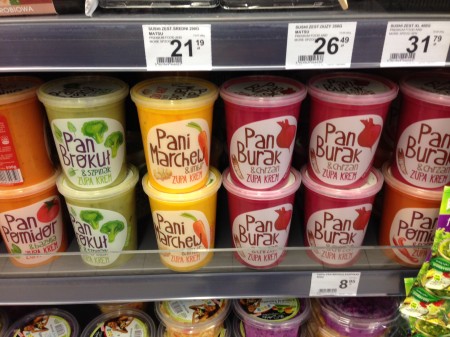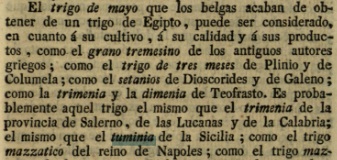 One of the fun things about visiting a new country is of course the food. There’s the formal cuisine, and the street food. 1 And the traditional markets with their food kiosks, and corner shops. But I also like to check out the supermarkets, both the big chains, and the smaller places. 2 I didn’t have much free time in Warsaw last week, just enough for a couple of visits to smallish supermarkets. But I can report that Poles seem to have an inordinate fondness for the juice of minor berries.
One of the fun things about visiting a new country is of course the food. There’s the formal cuisine, and the street food. 1 And the traditional markets with their food kiosks, and corner shops. But I also like to check out the supermarkets, both the big chains, and the smaller places. 2 I didn’t have much free time in Warsaw last week, just enough for a couple of visits to smallish supermarkets. But I can report that Poles seem to have an inordinate fondness for the juice of minor berries.
Data, data everywhere… Wheat edition
Speaking of wheat, I know we Nibbled yesterday the arrival of yet another germplasm database, the Seeds of Discovery (SeeD) Wheat Catalog (there’s also a maize one), but I couldn’t resist another bite at that cherry. If only because some of the material is on its way to Svalbard right now. The Seeds of Discovery catalogues are still works in progress, but already really important achievements:
At this point, the database contains an exemplary dataset of genotyping-by-sequencing (GBS) profiles of selected landraces, synthetic bread wheats and modern cultivars; the passport data of Mexican landraces; and the Principal Coordinates (PCO) describing the genetic structure of a broad set of more than 10,000 Mexican and Iranian landraces, modern varieties and synthetic bread wheats.
My plea for the developers, as they work on the portal further, is that they do not lose sight of the fact that what they’re dealing with here is accessions in a genebank. I can see no way for a peruser of the Catalogue, intrigued by the genotype of an accession, to actually ask for seed. You know, like the stuff that’s going up to Svalbard. What you’d currently have to do is cut the accession number and paste it into the genebank’s documentation system or Genesys. I’ve done it, and it works, but it’s not particularly elegant. Or am I missing something? Maybe Seeds of Discovery and the CIMMYT genebank, who I know work very closely together, could expand a little on how they see their two databases linking up in the future.
Another slice of tumminia bread
For those readers who were intrigued by Jacob’s somewhat enigmatic comment on tumminia wheat, but put off by having to download a huge PDF of an 1818 edition of the Memorias de Agricoltura y Artes, in Spanish, here’s the money quote:
And here’s a quick translation:
The May wheat that the Belgians have recently obtained from an Egyptian wheat can be considered, based on its agronomy, its quality and its products, to be the same as the tremesino wheat of the ancient Greek authors; the three month wheat of Pliny and Columella; the setanio of Dioscorides and Galen; the trimenia and dimenia of Theophrastus. It is probably the trimenia of the province of Salerno, of Lucana and Calabria; the same as the tuminia of Sicily; the mazzatico wheat of the Kingdom of Naples; the mazzuolo wheat of the Tuscans.
People have been exchanging crop diversity, and been interdependent on each other for it, for a long time, I guess.
Jeremy has more on the etymology of tumminia in another comment.
Let there always be Pane Nero di Castelvetrano
It all started with a photo of “tumminia bread” on Instagram. It looked yummie, but I’d never heard of tumminia. A picturesque hamlet? A time-honoured though back-breaking mode of preparation? Some ancient grain hanging on precariously on the outskirts of encroaching modernity? A treasured local variety of wheat nurtured by gnarled rustics? I had to know. A little googling revealed that the name refers to an ingredient in the Pane Nero di Castelvetrano, a dark bread made in a small town in the Sicilian province of Trapani.
The bread is made using a leaven system. The flour mix is 80% local and refined semolina durum, described as “blonde grain”. I believe this will be the equivalent grind to “rimacinata”, if I’m not wrong. The other 20% of the flour is from the tumminia durum wheat grain, which is milled quite coarsely, and is a wholegrain flour.
So the next job was to hunt down in genebanks that treasured local variety of durum. Because how long will it continue to be nurtured by gnarled Sicilian rustics in the picturesque hamlet of Castelvetrano, out there on the outskirts of modernity? Thankfully, Genesys says that there are two accessions of tumminia at ICARDA and another two at IPK. They’re not duplicates, I don’t think, the former having been collected in 1973 and the latter in 1985. They all come from Sicily, but the ICARDA accessions from near Aragona, some 100 km southeast of Castelvetrano along the coast, and the IPK accessions from Bisacquino, which is a bit closer, about 60 km east, in the mountains. So several picturesque hamlets are involved, or at least that was the case 30-40 years ago.
Anyway, if you go to the European Wheat Database you get a little bit of additional information, but unfortunately I can’t link to it, so I’ll have to hand-hold you through it. See that thing that says “single search” down the left-hand side? Click on it, and where is says accession name, type tumminia to get to the IPK accessions; now click on either accession number. You’ll get to the passport information on our Sicilian durum accession. Scroll down and on the right-hand side you’ll see a button marked “Link to pedigree catalogue.” If you click on that you’ll land on the entry for tumminia in Zeven’s Genealogies of 14000 wheat varieties, published in 1976. Which says that it is a Spanish landrace. 3 Awkward. Maybe the gnarled rustics that originally nurtured tumminia are in altogether a different picturesque hamlet, in a different country? Or maybe Zeven was wrong.
Be that as it may, I think we can rest assured that, genetically speaking at least, the key ingredient of Pane Nero di Castelvetrano is probably pretty safe. Even if fewer picturesque hamlets grow tumminia nowadays than formerly, and for all I know the opposite is true, there are those 4 accessions to fall back on, in two separate genebanks, plus safety duplications, and probably even Svalbard. Now to make sure that back-breaking mode of preparation is likewise safe from encroaching modernity.
French grape genebank on the move?
After Pavlovsk and Brogdale, it is now the turn of a French fruit genebank to feel the heat. According to Declan Butler’s somewhat breathless piece in Nature:
Uncertainty hangs over one of the world’s largest and most important grapevine collections. The Domaine de Vassal vineyard, on France’s Mediterranean coast, houses a vast sweep of grape biodiversity that is essential to research and winegrowers in France and around the world.
That would be the Station de Recherches Viticoles of the Institut national de la recherche agronomique (INRA). For those that know genebank-speak, that is institute FRA139. Plug that into the “institute code” slot on ECPGR’s Vitis database page to get the details of its holdings. Or you can get summary data from WIEWS. It’s actually not the only grape genebank in France, but there’s no word on overlap with other French collections, or indeed with collections in other parts of the world. Numbers vary among the sources, but this collection represents maybe half of France’s holdings of cultivated grape accessions, and a tenth of the world’s. 4
So it’s an important collection, large and well documented, both phenotypically and genotypically. What’s the problem? Well, the lease is running out on the land it’s been on for the past 138 years, and it needs to shift. The move will cost €4 million, and the money isn’t in the budget. INRA says it’s committed to maintaining the collection, and will find the cash. The boffins fret and worry about the disruption to research and possible losses in the process. I asked our friends at the Myles Lab in Canada for their opinion and they do see an upside:
@AgroBioDiverse @BrianFLloyd @plantbiology 1/2 The move is a good idea – offers chance to plant collection in specific experimental design
— Foodimprover (@foodimprover) February 7, 2014
But it is worrying. We’ll keep an eye on it for you.

